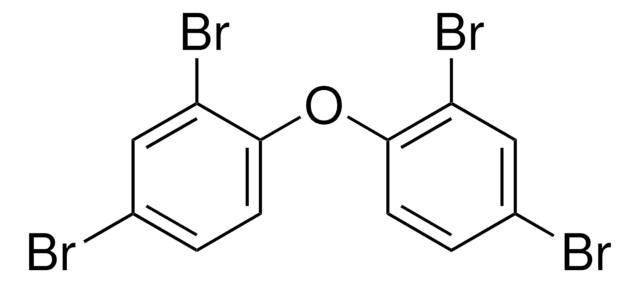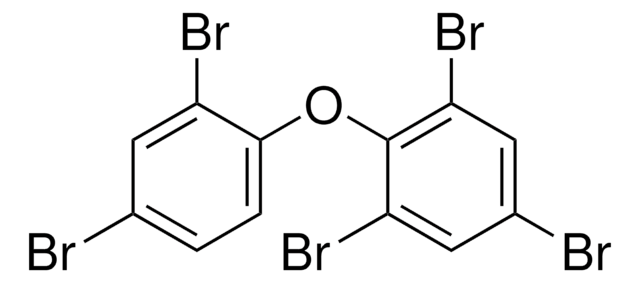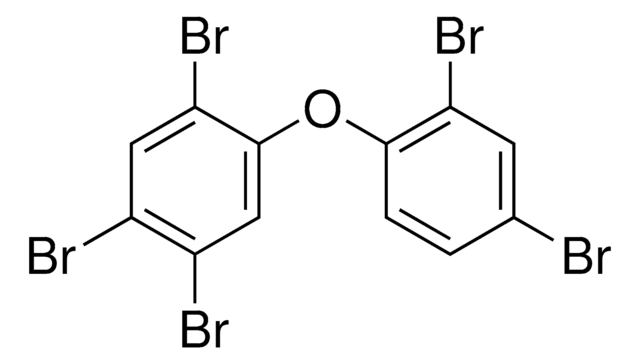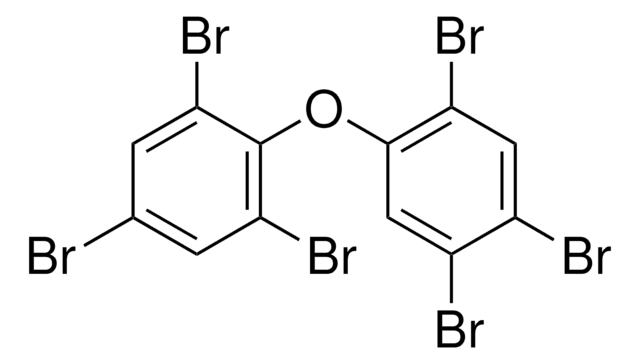33683
BDE No 153
50 μg/mL in isooctane, analytical standard
Sinonimo/i:
2,2′,4,4′,5,5′-Hexabromodiphenyl ether, 2,2′,4,4′,5,5′-HexaBDE, PBDE 153
About This Item
Prodotti consigliati
Grado
analytical standard
Durata
limited shelf life, expiry date on the label
Concentrazione
50 μg/mL in isooctane
tecniche
HPLC: suitable
gas chromatography (GC): suitable
applicazioni
environmental
Formato
single component solution
Temperatura di conservazione
2-8°C
Stringa SMILE
Brc1cc(Br)c(Oc2cc(Br)c(Br)cc2Br)cc1Br
InChI
1S/C12H4Br6O/c13-5-1-9(17)11(3-7(5)15)19-12-4-8(16)6(14)2-10(12)18/h1-4H
RZXIRSKYBISPGF-UHFFFAOYSA-N
Categorie correlate
Descrizione generale
Applicazioni
- House dust samples using isotope dilution method combined with liquid chromatography coupled to negative ionization atmospheric pressure photoionization tandem mass spectrometry (LC-NI-APPI-MS/MS).
- Adipose tissue samples using gas chromatography coupled to ion-trap mass spectrometry (GC-IT-MS/MS).
Altre note
The standard should be transferred to a clean and appropriate vial or flask using clean pipettes or micro pipettes. The vial should be immediately capped to avoid any loss or evaporation of the solvent.
After opening the ampoule, the standard should not be stored or kept in the ampoule. To preserve the integrity of the product, the standard should be transferred to an appropriate vial that must be capped and stored according to the recommendation on the Certificate of Analysis.
Avvertenze
Danger
Indicazioni di pericolo
Consigli di prudenza
Classi di pericolo
Aquatic Acute 1 - Aquatic Chronic 1 - Asp. Tox. 1 - Flam. Liq. 2 - Skin Irrit. 2 - STOT SE 3
Organi bersaglio
Central nervous system
Codice della classe di stoccaggio
3 - Flammable liquids
Classe di pericolosità dell'acqua (WGK)
WGK 2
Punto d’infiammabilità (°F)
10.4 °F
Punto d’infiammabilità (°C)
-12 °C
Dispositivi di protezione individuale
Eyeshields, Faceshields, Gloves, type ABEK (EN14387) respirator filter
Scegli una delle versioni più recenti:
Possiedi già questo prodotto?
I documenti relativi ai prodotti acquistati recentemente sono disponibili nell’Archivio dei documenti.
I clienti hanno visto anche
Il team dei nostri ricercatori vanta grande esperienza in tutte le aree della ricerca quali Life Science, scienza dei materiali, sintesi chimica, cromatografia, discipline analitiche, ecc..
Contatta l'Assistenza Tecnica.










